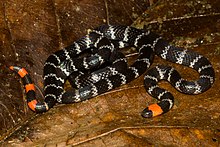Micrurus mipartitus: Difference between revisions
Appearance
Content deleted Content added
Tisquesusa (talk | contribs) No edit summary |
Filled in 2 bare reference(s) with reFill () |
||
| Line 7: | Line 7: | ||
}} |
}} |
||
'''''Micrurus mipartitus''''' ('''redtail coral snake''') is a species of [[coral snake]] in the family [[Elapidae]].<ref name=RDB>{{NRDB species|genus=Micrurus|species=mipartitus|accessdate=20 December 2016}}</ref> It is found in [[South America]] and [[Central America]]. The redtail coral snake is common in agricultural areas in [[Colombia]].<ref>https://jvat.biomedcentral.com/articles/10.1186/s40409-017-0100-4</ref> Its highly [[neurotoxins|neurotoxic]] venom is known to cause [[seizures]] in its prey by activating [[nerve]] [[proteins]] responsible for seizures within it.<ref>http://www.reptilesmagazine.com/Snakes/Information-News/Red-Tail-Coral-Snake-Venom-Activates-Nerve-Cell-Proteins-That-Cause-Seizures/</ref> |
'''''Micrurus mipartitus''''' ('''redtail coral snake''') is a species of [[coral snake]] in the family [[Elapidae]].<ref name=RDB>{{NRDB species|genus=Micrurus|species=mipartitus|accessdate=20 December 2016}}</ref> It is found in [[South America]] and [[Central America]]. The redtail coral snake is common in agricultural areas in [[Colombia]].<ref name="auto">{{cite journal|url=https://jvat.biomedcentral.com/articles/10.1186/s40409-017-0100-4|title=Envenomation by the red-tailed coral snake (Micrurus mipartitus) in Colombia|first1=Carlos A.|last1=Cañas|first2=Fernando|last2=Castro-Herrera|first3=Santiago|last3=Castaño-Valencia|date=14 February 2017|publisher=|journal=Journal of Venomous Animals and Toxins including Tropical Diseases|volume=23|issue=1|accessdate=19 July 2018|doi=10.1186/s40409-017-0100-4|pmid=28228775|pmc=PMC5307858}}</ref> Its highly [[neurotoxins|neurotoxic]] venom is known to cause [[seizures]] in its prey by activating [[nerve]] [[proteins]] responsible for seizures within it.<ref>{{cite web|url=http://www.reptilesmagazine.com/Snakes/Information-News/Red-Tail-Coral-Snake-Venom-Activates-Nerve-Cell-Proteins-That-Cause-Seizures/|title=Red Tail Coral Snake Venom Activates Nerve Cell Proteins That Cause Seizures|website=www.reptilesmagazine.com|accessdate=19 July 2018}}</ref> |
||
==Phenotypic features== |
==Phenotypic features== |
||
The M. mipartitus has a cylindric body that can reach up to 1.22 meters in length. They have quite small eyes upon their round heads. The rings of this species can range anywhere from 34-84 black bodily rings that are sundered by yellow or white intermediaries. The second ring on the head and 3 or 4 of the tail rings exude a red color in contrast to the white or yellow bands.<ref |
The M. mipartitus has a cylindric body that can reach up to 1.22 meters in length. They have quite small eyes upon their round heads. The rings of this species can range anywhere from 34-84 black bodily rings that are sundered by yellow or white intermediaries. The second ring on the head and 3 or 4 of the tail rings exude a red color in contrast to the white or yellow bands.<ref name="auto"/> |
||
== References == |
== References == |
||
Revision as of 21:38, 19 July 2018
| Micrurus mipartitus | |
|---|---|

| |
| Scientific classification | |
| Domain: | Eukaryota |
| Kingdom: | Animalia |
| Phylum: | Chordata |
| Class: | Reptilia |
| Order: | Squamata |
| Suborder: | Serpentes |
| Family: | Elapidae |
| Genus: | Micrurus |
| Species: | M. mipartitus
|
| Binomial name | |
| Micrurus mipartitus | |
Micrurus mipartitus (redtail coral snake) is a species of coral snake in the family Elapidae.[1] It is found in South America and Central America. The redtail coral snake is common in agricultural areas in Colombia.[2] Its highly neurotoxic venom is known to cause seizures in its prey by activating nerve proteins responsible for seizures within it.[3]
Phenotypic features
The M. mipartitus has a cylindric body that can reach up to 1.22 meters in length. They have quite small eyes upon their round heads. The rings of this species can range anywhere from 34-84 black bodily rings that are sundered by yellow or white intermediaries. The second ring on the head and 3 or 4 of the tail rings exude a red color in contrast to the white or yellow bands.[2]
References
- ^ Micrurus mipartitus at the Reptarium.cz Reptile Database. Accessed 20 December 2016.
- ^ a b Cañas, Carlos A.; Castro-Herrera, Fernando; Castaño-Valencia, Santiago (14 February 2017). "Envenomation by the red-tailed coral snake (Micrurus mipartitus) in Colombia". Journal of Venomous Animals and Toxins including Tropical Diseases. 23 (1). doi:10.1186/s40409-017-0100-4. PMC 5307858. PMID 28228775. Retrieved 19 July 2018.
{{cite journal}}: CS1 maint: PMC format (link) CS1 maint: unflagged free DOI (link) - ^ "Red Tail Coral Snake Venom Activates Nerve Cell Proteins That Cause Seizures". www.reptilesmagazine.com. Retrieved 19 July 2018.
